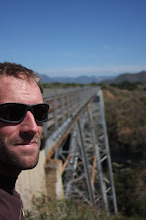Starting off my 2011 trip through southeast Mexico, I began a day at the Ferrosur yard in Irolo Mexicano, Hidalgo hoping to catch the local that runs north to Linea H and Honey. I've always wanted to photograph the train passing underneath the impressive Arcos del Padre Tembleque on that line. However, when I arrived at the yard, I found a set of engines switching, building a train to depart southward. As luck would have it, they were instead taking a long cut of loaded grain hoppers to the massive grain elevators on Linea HB near Calpulalpan. This is the former narrow gauge Ferrocarril Interoceánico line to Puebla.
 |
A Ferrosur Super 7 and a former AT&SF SF30C switch at the south end of Irolo Mexicano yard. The track in the foreground is Linea HB, now a branchline to the KCSM connection and Calpulalpan. The Ferrosur mainline to Veracruz (Linea S) can be seen to the right. Notice the strange bridge-like structure that the tracks pass over in the foreground.
|
As seen from a cemetery above Irolo, the local departs onto the branchline. Ferrosur's Linea S mainline to the east coast is visible above the train.
 |
| Passing through a series of curves, the train is approaching PK-HB34. |
 |
| A rancher is watching over his sheep on horseback while the train approaches San Lorenzo (Emilio Zapata is the current name of the town), where it will enter KCSM trackage rights for a short run on Linea V. Notice that the KCSM line is visible in the distance. Linea V is the former FC Interoceanico mainline between Mexico City and Veracruz via Oriental and Xalapa. |
 |
| At the south end of San Lorenzo, the Super 7 and SF30-C curve off of KCSM trackage onto Linea HB again. |
 |
| Ferrosur 9521 is a former AT&SF SF30-C, still with it's unique nose shape and wearing its original Santa Fe number. For many years, I have been hoping to find this engine. It is one of only two such engines to be found in Mexico - both are on the Ferrosur roster. |


















